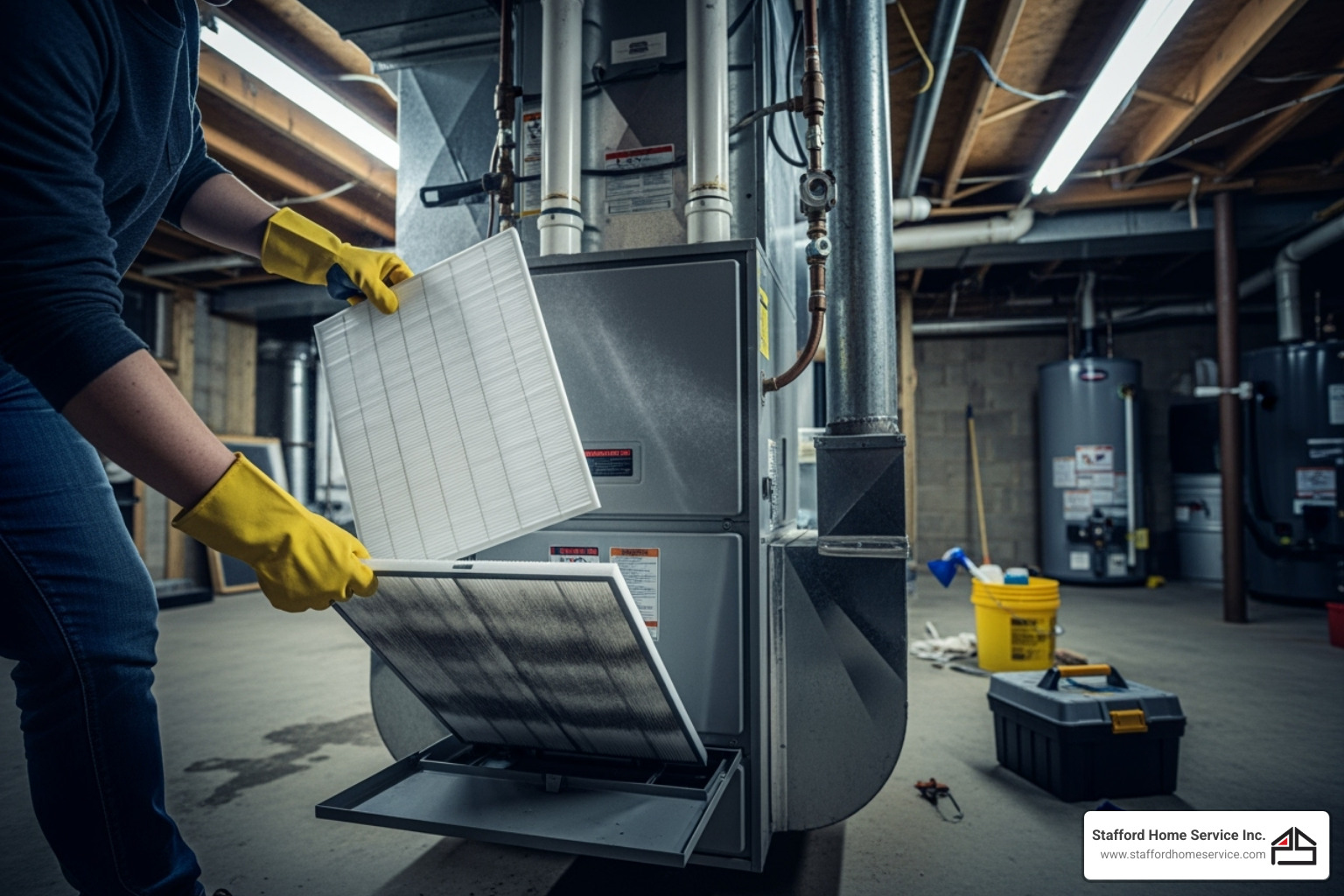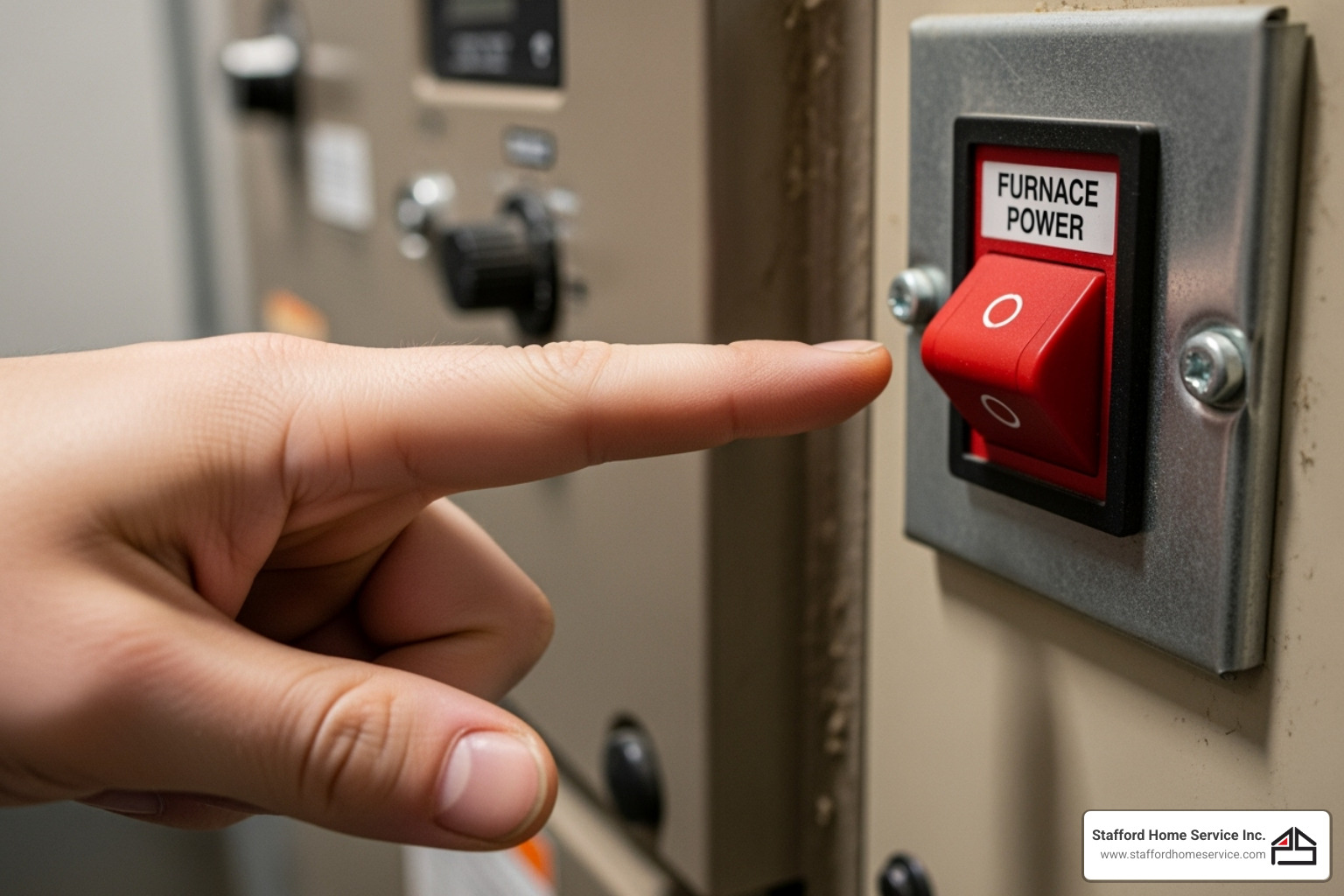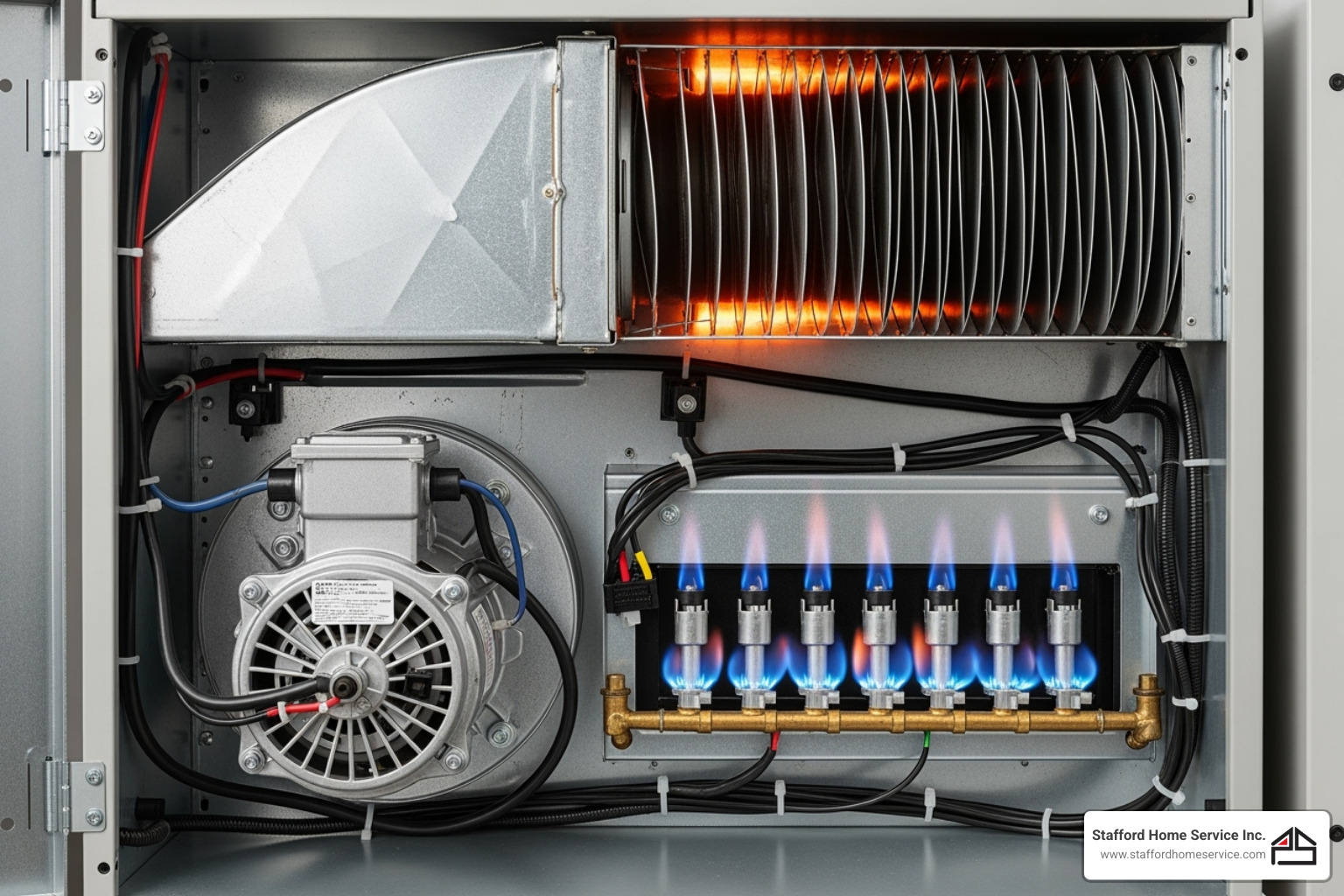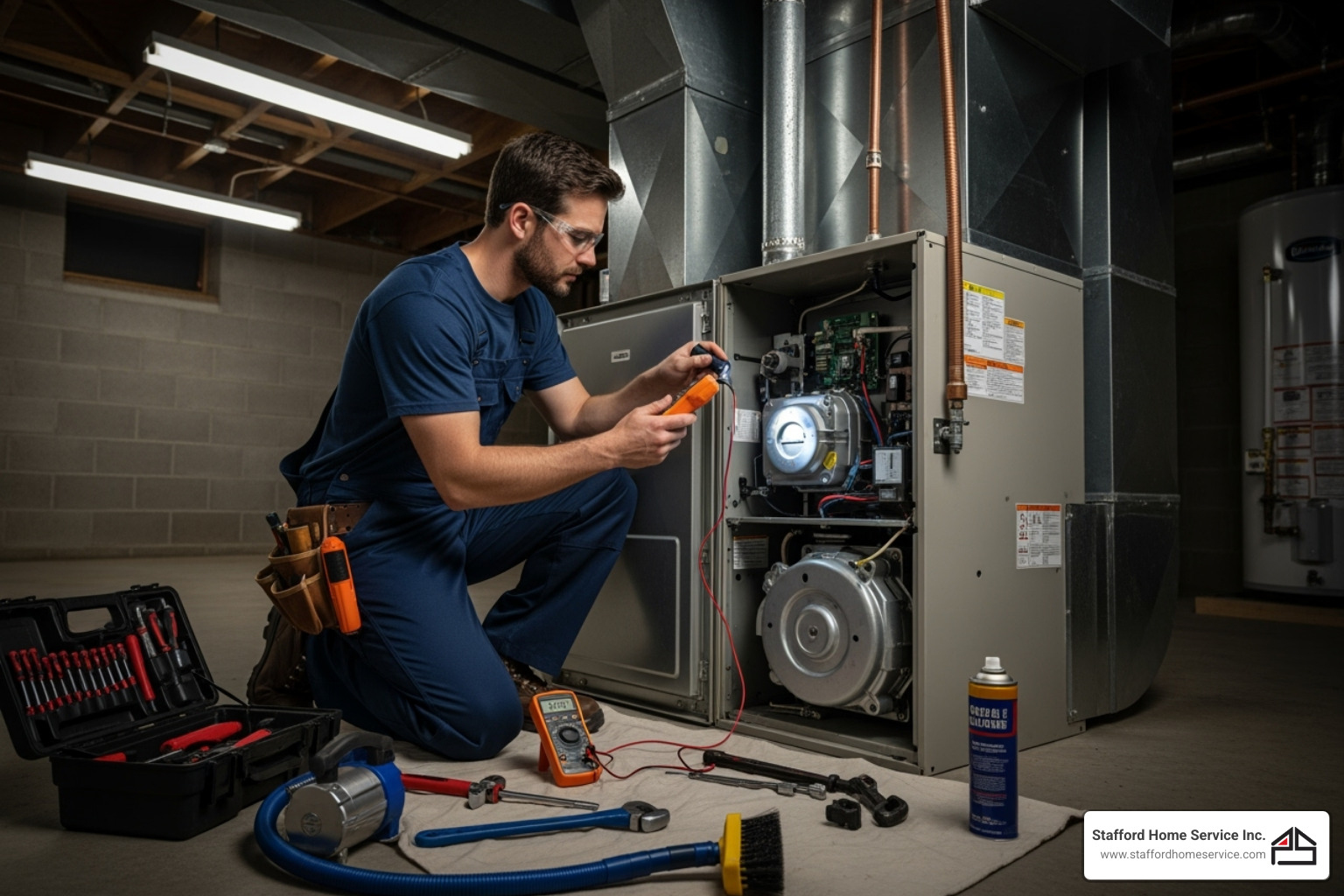When Your Home Goes Cold: Quick Solutions for a Heater Not Working
When your heater not working leaves you shivering in your own home, you need answers fast. The good news? Most heating problems have simple causes that you can check yourself before calling for help.
Quick troubleshooting steps for a non-working heater:
- Check thermostat settings – Ensure it’s set to “heat” and temperature is higher than room temp
- Replace air filter – A clogged filter can shut down your system
- Verify power supply – Check circuit breakers and furnace power switch
- Inspect pilot light – For gas heaters, make sure it’s lit
- Clear blocked vents – Remove furniture or debris blocking airflow
Nothing beats the comfort of a warm home during cold weather. But when your heating system fails, it can turn your cozy space into an icebox. Research shows that most homeowner heating complaints stem from just a few common issues – many of which you can fix in minutes.
The key is knowing where to look first. Power problems, dirty filters, and simple thermostat mistakes cause the majority of “no heat” calls to HVAC companies. Before you reach for the phone, a few quick checks might save you time and money.
Some heating issues require professional attention for safety reasons. Gas leaks, electrical problems, and component failures need expert diagnosis. But many times, your heater just needs a small adjustment to get back to keeping you comfortable.
Start with the Basics: Simple DIY Heater Checks
When you wake up to a cold house and your heater not working, it’s natural to feel a bit panicked. But before you start imagining worst-case scenarios or reaching for your phone to call for help, take a deep breath. Most heating problems have surprisingly simple causes that you can check yourself in just a few minutes.
Think of this as detective work. Your heating system is trying to tell you something, and these basic checks will help you understand what’s going wrong. We’ve seen countless homeowners save themselves time, money, and stress by starting with these fundamentals.
Check Your Thermostat Settings
Your thermostat is like the captain of your heating ship, but sometimes even captains make mistakes. It might sound too simple, but thermostat issues are behind many heater not working calls we receive.
Start with the basics: make sure your thermostat is actually set to “Heat” mode. You’d be surprised how often someone accidentally switches it to “Cool” or “Off” while dusting or adjusting the temperature. Next, check that your target temperature is higher than what your home currently feels like. If it’s 65°F inside and your thermostat is set to 62°F, your heater is just doing what you told it to do – nothing!
The fan setting matters too. If it’s set to “On” instead of “Auto,” your system will blow air constantly, even when it’s not heated. This creates that frustrating situation where you feel cold air coming from your vents.
Dead batteries are the silent troublemaker of the thermostat world. If your digital thermostat screen looks dim, blank, or shows a battery symbol, try fresh batteries first. It’s amazing how this simple fix can bring your whole heating system back to life.
Smart thermostats add another layer of complexity. Check that yours is still connected to your Wi-Fi and hasn’t lost its programming. Sometimes these devices reset themselves or get accidentally reprogrammed, creating heating schedules that don’t match your needs.
If your thermostat seems completely unresponsive even after checking these basics, the device itself might be malfunctioning. A faulty thermostat can’t communicate properly with your furnace, leaving you in the cold. You can learn more about common costly home heating mistakes that might be affecting your comfort and energy bills.
Inspect and Replace the Air Filter
Here’s something that might surprise you: your air filter could be the villain behind your heater not working. Think of it as your heating system’s lungs – when they’re clogged, everything struggles.
Your furnace filter works hard to trap dust, pet hair, pollen, and all sorts of airborne particles that would otherwise circulate through your home. But when it gets too dirty, it becomes like trying to breathe through a thick blanket. Your heating system can’t get the airflow it needs to operate properly.
When airflow gets restricted, your heater has to work much harder to do its job. Modern heating systems are smart enough to protect themselves – many will actually shut down if they detect poor airflow to prevent damage from overheating. This safety feature can leave you wondering why your heater not working when it’s actually just protecting itself.
Most disposable filters need replacing every one to three months, especially during heavy heating season. If you have a washable filter, it needs regular cleaning according to the manufacturer’s instructions.
Watch for these warning signs that your filter needs attention: weaker airflow from your vents, higher than usual energy bills, a filter that looks gray or black with dirt, musty or dusty smells throughout your home, or your heater turning on and off more frequently than normal.
The good news is that checking your filter takes about 30 seconds, and replacing it takes just a few minutes. It’s one of the easiest ways to keep your heating system happy and your home comfortable. Scientific research shows how airflow obstruction can significantly impact system performance.
What to Do When Your Heater is Not Working Due to Power Issues
Sometimes the answer to your heater not working problem is as simple as flipping a switch. Power issues are surprisingly common culprits, and they’re often the easiest to fix once you know where to look.
Start your power investigation at your home’s electrical panel. Look for any tripped circuit breakers – they’ll be flipped to the “off” position or stuck somewhere between “on” and “off.” If you find one, flip it completely off first, then back to “on.” This reset procedure is important for the breaker to work properly.
Older homes might have fuses instead of circuit breakers. A blown fuse will look obviously damaged and needs to be replaced with one that has the same rating. Never use a higher-rated fuse, as this creates a fire hazard.
Next, hunt down your furnace power switch. This looks just like a regular light switch and is usually mounted on the wall near your furnace or on a junction box attached to the unit. Make sure it’s in the “on” position. You’d be amazed how often this switch gets accidentally turned off during cleaning or by curious family members who don’t know what it controls.
If you’re still having power troubles, test the outlet itself by plugging in something else, like a lamp, to make sure electricity is flowing. For electric heaters, always plug directly into a wall outlet rather than using extension cords or power strips, which might not provide adequate power.
Here’s an important safety note: if a circuit breaker keeps tripping repeatedly, don’t keep forcing it back on. This signals a deeper electrical problem that needs professional attention. Persistent electrical issues can create fire hazards and should never be ignored.
Why Your Heater is Not Working: Common Culprits
After checking the basics like your thermostat, air filter, and power supply, it’s time to look deeper into your heating system. When your heater not working persists despite these simple fixes, the problem likely lies within specific components that need a closer look. Don’t worry – understanding these issues can help you communicate better with professionals and sometimes even spot solutions yourself.
My Gas Heater is Not Working: Checking the Pilot Light and Fuel Supply
Gas furnaces are wonderful when they work, but when they don’t, the culprit is often hiding in plain sight. If your gas heater not working, the ignition system is your first suspect.
Many older gas furnaces depend on a standing pilot light – that little blue flame that burns continuously, ready to ignite your main burners when you need heat. When this flame goes out, your furnace essentially becomes a very expensive paperweight. The pilot light can be extinguished by drafts, a dirty pilot orifice, or a failing thermocouple (the safety device that monitors the flame).
Most furnaces have relighting instructions printed right on the unit, usually on a metal plate near the gas controls. These step-by-step directions are your roadmap back to warmth. Always follow them exactly, and keep your owner’s manual handy for reference.
Newer gas furnaces use electronic ignition systems instead of constantly burning pilot lights. These systems use either a hot surface igniter or an intermittent pilot that only fires when heat is needed. If your modern furnace won’t start, the igniter might be cracked, dirty, or simply worn out from years of service.
But ignition is only half the story. Your furnace also needs an adequate fuel supply to work properly. For natural gas systems, check that the gas valve leading to your furnace is fully open – the handle should run parallel to the gas pipe. If you heat with propane, make sure your tank has at least 25% fuel remaining. A nearly empty tank can cause your furnace to struggle or shut down completely.
Critical Safety Warning: If you detect even the faintest smell of gas, stop everything immediately. Don’t flip switches, light matches, or continue troubleshooting. Turn off your heater, evacuate your home, open doors and windows, and call your gas company right away. Gas leaks require professional expertise – this isn’t a DIY situation. For additional insights into similar issues, you can learn more about how to identify and fix boiler repair issues.
Is Poor Airflow the Problem? Vents and Ductwork
Sometimes your furnace is working perfectly, but poor airflow makes it feel like your heater not working effectively. You might notice some rooms staying cold while others feel comfortable, or weak airflow from your vents even after replacing the filter.
Start by playing detective with your vents and registers. Walk through your home and check every supply and return vent. Are any blocked by furniture that’s been pushed too close? Is that new area rug covering a floor register? Even partially blocked vents can significantly impact your system’s ability to distribute heat evenly throughout your home.
The real troublemaker often lurks behind the walls in your ductwork system. Over time, ducts can develop problems that steal your heat before it reaches you. Leaky ducts are particularly sneaky – they allow your expensive heated air to escape into attics, basements, or crawl spaces where it does you no good. Disconnected duct sections can leave entire rooms without proper heating, while obstructions inside the ducts (think accumulated dust, debris, or even small critters) can choke off airflow.
You might suspect ductwork problems if you notice uneven heating throughout your home, higher than usual energy bills, or reduced airflow from vents even with a clean filter. While you can easily clear visible obstructions around vents, addressing leaky or damaged ductwork typically requires professional inspection and sealing.
The good news is that improving your ductwork can dramatically boost your heating system’s efficiency and your home’s comfort. For more comprehensive guidance on diagnosing these and other heating issues, check out our detailed guide on how to diagnose and fix heater problems.
When to Call a Professional HVAC Technician
While many common heater problems can be resolved with simple DIY checks, there are times when a heater not working signals a more serious issue that requires the expertise of a professional HVAC technician. Knowing when to call in the pros is crucial for your safety and the longevity of your heating system.
Critical Safety Warnings: Don’t Ignore These Signs
Some warning signs are your heating system’s way of crying for help – and these cries should never be ignored. If you encounter any of these situations, your safety depends on turning off your heater immediately and contacting a qualified professional.
A burning smell when you first fire up your heater after months of sitting idle is usually just dust burning off the heat exchanger – think of it as your furnace clearing its throat. This should disappear within a few minutes. However, if you smell something like melting plastic, rubber, or electrical components burning, that’s your cue to act fast. This could mean overheating wiring or a malfunctioning motor, both serious fire hazards.
The smell of gas anywhere near your furnace is an absolute emergency. Natural gas and propane are given that distinctive “rotten egg” odor specifically so you can detect leaks. If you catch even a whiff of this smell, don’t be a hero – evacuate your home immediately. Don’t flip any light switches or use electrical devices. Call your gas provider from a safe distance, then contact a licensed HVAC professional.
Carbon monoxide risk is perhaps the most insidious danger because this deadly gas is completely invisible and odorless. A cracked heat exchanger can allow carbon monoxide to seep into your home’s air supply. The symptoms often mimic the flu – headaches, nausea, and dizziness – which makes it easy to dismiss. Installing carbon monoxide detectors throughout your home isn’t just smart; it’s potentially life-saving.
When your circuit breaker keeps tripping despite your attempts to reset it, your electrical system is essentially throwing up a red flag. Persistent electrical issues like this, along with any sparks or loose wiring you might spot, require immediate professional attention. Your heating system is trying to tell you something important.
For comprehensive guidance on keeping your family safe, check out our detailed furnace safety tips.
Signs of a Deeper Problem
Beyond immediate safety concerns, your heater not working might be sending you subtler signals that something more complex is going wrong under the hood. These issues typically require professional diagnostic tools and the trained eye of an experienced technician.
Your furnace should hum along quietly in the background, so when it starts making a racket, pay attention. Banging or popping sounds often mean loose panels or issues with the burner, while squealing or screeching usually points to worn-out belts or failing motor bearings in the blower motor. Rattling noises can indicate loose parts, a struggling blower motor, or debris that’s found its way inside the unit.
The blower motor is essentially your heating system’s lungs, responsible for pushing warm air throughout your home. When it starts failing, you might notice weak airflow, no airflow, or those strange noises we mentioned. A faulty blower motor or worn-out bearings can bring your entire system to a grinding halt.
Heat exchanger cracks represent one of the most serious problems your furnace can develop. Beyond the carbon monoxide danger, you might notice soot or rust appearing on the outside of your furnace, unusual odors coming from your vents, or in severe cases, visible cracks (though only a professional should inspect for these).
Frequent cycling – when your heater turns on and off repeatedly in short bursts – is like your system having hiccups. While this can sometimes be caused by a dirty air filter leading to overheating, it often signals deeper internal problems that require professional diagnosis.
When you’ve methodically worked through all the basic troubleshooting steps and your heater not working problem persists, it’s time to wave the white flag and call in reinforcements. Attempting to fix complex mechanical issues without proper training can turn a manageable repair into a major overhaul.
Regular professional maintenance helps catch issues like worn belts and failing motor bearings before they leave you in the cold. If you’re noticing any of these warning signs, especially if your system is showing its age, it might be worth reading our guide on signs you need to replace your heating system to understand whether repair or replacement makes more sense for your situation.
Frequently Asked Questions about Heater Problems
When your heater not working leaves you in the cold, questions start racing through your mind. We’ve been helping homeowners across Minneapolis, Edina, Golden Valley, Minnetonka, Plymouth, St Louis Park, and throughout Minnesota for years, and we hear the same concerns over and over. Let’s tackle the most common ones together.
Why is my heater blowing cold air?
Nothing’s more frustrating than feeling cold air coming from your vents when you’re expecting warmth! This puzzling problem usually has a straightforward explanation.
First, check your thermostat’s fan setting. If it’s set to “On” instead of “Auto,” your fan runs constantly – even when the heating elements aren’t working. This means you’ll feel air movement, but it won’t be warm. Switch it to “Auto” and see if that solves the problem.
A clogged air filter is another common culprit. When your filter gets severely dirty, it blocks airflow and causes your furnace to overheat. Your furnace has built-in safety features that shut down the burner when things get too hot, but the fan keeps running to cool things down. Result? Cold air blowing through your vents.
For gas furnaces, pilot light or ignition problems mean no flame, which means no heat. Your fan might still blow, but without the burners firing up, you’re just circulating unheated air. Similarly, if your gas valve is turned off or your propane tank is running low, there’s no fuel to create heat.
Sometimes your furnace’s overheating safety switch trips due to restricted airflow or a faulty component. The heating elements shut off for protection, but the fan continues running to cool down the system. This is your furnace’s way of protecting itself from damage.
How often should I change my furnace filter?
This question comes up constantly, and the answer isn’t one-size-fits-all. It depends on your specific situation and home environment.
Basic pleated filters typically need changing every one to three months, while higher-efficiency filters (MERV 8-11 ratings) can often last three to six months. But your home’s unique conditions matter more than general guidelines.
If you have pets that shed, especially cats or dogs with longer fur, you’ll need to change filters more frequently – sometimes monthly. The same goes for homes with family members who have allergies or asthma, where cleaner air is crucial for health and comfort.
Dusty environments also demand more frequent filter changes. If you live near construction, have ongoing home renovations, or your area tends to be naturally dusty, plan on monthly replacements.
Here’s our practical advice: check your filter monthly regardless of what type you use. Hold it up to the light – if you can’t see through it clearly, it’s time for a new one. Most filters should be changed every one to three months for optimal performance and energy efficiency. And never, ever run your furnace without a filter – dust and debris can damage expensive internal components.
What does a burning smell from my heater mean?
A burning smell from your heater can make your heart skip a beat, but don’t panic immediately. The context and type of smell make all the difference.
When you first fire up your heater after months of sitting idle, a light burning smell is completely normal. Dust settles on heating elements and throughout your ductwork during the off-season. When your system kicks on, this dust burns off, creating that distinctive smell. This initial dust burn-off should disappear within a few hours of operation.
However, a persistent burning smell that lasts more than a few hours is a different story entirely. If you smell something that reminds you of melting plastic, burning rubber, or electrical wires, turn off your heater immediately.
These concerning smells often indicate an overheating motor, where your blower motor is working too hard and getting dangerously hot. Electrical issues like frayed wires, loose connections, or short circuits also produce acrid burning odors – and these pose serious fire hazards.
Sometimes severely restricted airflow from clogged filters or blocked vents causes your entire system to overheat, leading to burning smells throughout the unit.
Our safety rule is simple: if the burning smell persists, seems unusual, or makes you uncomfortable, shut down your heater and call a professional. It’s always better to be safe than sorry when it comes to potential fire hazards in your home.
Get Your Heat Back On for Good
When your heater not working leaves you shivering, we hope this guide has helped you troubleshoot your way back to cozy warmth. Sometimes the fix is as simple as flipping a switch or swapping out a dirty air filter. Other times, you’ve done everything right, but your heating system still needs professional attention.
The truth is, not every heating problem is a DIY project – and that’s perfectly okay. Gas leaks, electrical issues, and complex component failures require the expertise and specialized tools that only trained HVAC technicians possess. There’s no shame in calling for help when safety is on the line or when you’ve reached the limits of basic troubleshooting.
Regular maintenance is your heating system’s best friend. Just like your car runs better with routine oil changes, your furnace performs more reliably with annual professional tune-ups. Regular maintenance extends your system’s lifespan, keeps your energy bills in check, and catches small problems before they turn into expensive emergencies. Think of it as insurance against those middle-of-the-night heating failures that always seem to happen during the coldest Minnesota winters.
A well-maintained heating system does more than just save money – it provides the reliable comfort your family deserves. When temperatures plummet, you shouldn’t have to worry about whether your heater will keep up.
At Stafford Home Service Inc., we understand how frustrating it can be when your heater not working disrupts your daily life. Our NATE-certified technicians bring years of experience to every service call, and our experienced owners ensure quality workmanship on every job. We stand behind our work with the Daikin Comfort Promise, and we offer financing options to make heating repairs accessible when you need them most.
Whether you’re dealing with a stubborn pilot light in Minneapolis, mysterious cold spots in Edina, or strange noises coming from your furnace in Golden Valley, Minnetonka, Plymouth, or St Louis Park, we’re here to help. Don’t spend another day bundled up in your own home.
Schedule your professional heating repair in Minneapolis, MN with Stafford Home Service Inc. today. Let us restore the warmth and comfort your home deserves – because everyone should feel cozy in their own space.








